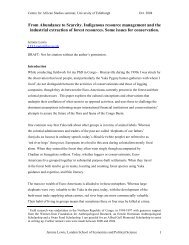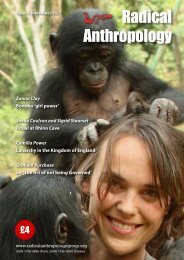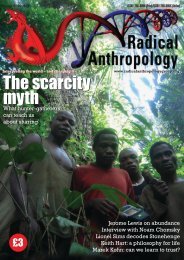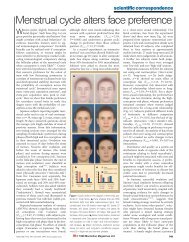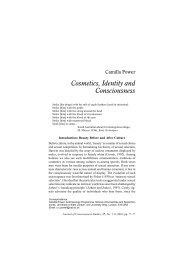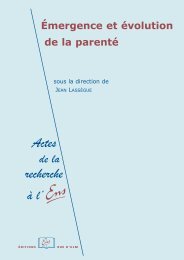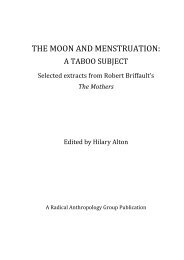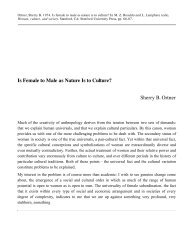Language and life history: A new perspective on the development ...
Language and life history: A new perspective on the development ...
Language and life history: A new perspective on the development ...
- No tags were found...
You also want an ePaper? Increase the reach of your titles
YUMPU automatically turns print PDFs into web optimized ePapers that Google loves.
References/Locke & Bogin: <str<strong>on</strong>g>Language</str<strong>on</strong>g> <str<strong>on</strong>g>and</str<strong>on</strong>g> <str<strong>on</strong>g>life</str<strong>on</strong>g> <str<strong>on</strong>g>history</str<strong>on</strong>g>Scamm<strong>on</strong>, R. E. (1930) The measurement of <strong>the</strong> body in childhood. In: Themeasurement of man, ed. J. A. Harris, C. M. Jacks<strong>on</strong>, D. G. Paters<strong>on</strong> & R. E.Scamm<strong>on</strong>, pp. 173–215. University of Minnesota Press. [aJLL]Scarr, S. & McCartney, K. (1983) How people make <strong>the</strong>ir own envir<strong>on</strong>ments:A <strong>the</strong>ory of genotype ^ envir<strong>on</strong>ment effects. Child Development54:424–35. [aJLL]Schaal, B., Tremblay, R. E., Soussignan, R. & Susman, E. J. (1996) Male testoster<strong>on</strong>elinked to high social dominance but low physical aggressi<strong>on</strong> in earlyadolescence. Journal of <strong>the</strong> American Academy of Child <str<strong>on</strong>g>and</str<strong>on</strong>g> AdolescentPsychiatry 34:1322–30. [aJLL]Schelletter, C. & Lein<strong>on</strong>en, E. (2003) Normal <str<strong>on</strong>g>and</str<strong>on</strong>g> language-impaired children’s useof reference: Syntactic versus pragmatic processing. Clinical Linguistics <str<strong>on</strong>g>and</str<strong>on</strong>g>Ph<strong>on</strong>etics 17:335–43. [aJLL]Scherer, K. R. (1979) Voice <str<strong>on</strong>g>and</str<strong>on</strong>g> speech correlates of perceived social influence insimulated juries. In: <str<strong>on</strong>g>Language</str<strong>on</strong>g> <str<strong>on</strong>g>and</str<strong>on</strong>g> social psychology, ed. H. Giles &R. St. Clair. Basil Blackwell. [aJLL]Schlegel, A. & Barry, H., III (1991) Adolescence: An anthropological inquiry. FreePress. [GEW]Schleidt, W. M. (1973) T<strong>on</strong>ic communicati<strong>on</strong>: C<strong>on</strong>tinual effects of discrete signs.Journal of Theoretical Biology 42:359–86. [WMS](1985) Learning <str<strong>on</strong>g>and</str<strong>on</strong>g> <strong>the</strong> descripti<strong>on</strong> of <strong>the</strong> envir<strong>on</strong>ment. In: Issues in <strong>the</strong> ecology oflearning, ed. T. D. Johnst<strong>on</strong> & A. T. Pietrewicz, pp. 305–25. Erlbaum. [WMS](1992) Biological bases of age specific behaviour – The compani<strong>on</strong>s in man’sworld. Evoluti<strong>on</strong> <str<strong>on</strong>g>and</str<strong>on</strong>g> Cogniti<strong>on</strong> 1:147–59. [WMS]Schleidt, W. M. & Crawley, J. N. (1980) Patterns in <strong>the</strong> behavior of organisms.Journal of Social <str<strong>on</strong>g>and</str<strong>on</strong>g> Biological Structure 3:1–15. [WMS]Schultz, A. H. (1960) Age changes in primates <str<strong>on</strong>g>and</str<strong>on</strong>g> <strong>the</strong>ir modificati<strong>on</strong> in man. In:Human growth, ed. J. M. Tanner, pp. 1–20. Pergam<strong>on</strong> Press. [SR](1969) The <str<strong>on</strong>g>life</str<strong>on</strong>g> of primates. Universe Books. [SR]Searle, J. (1972) What is a speech act? In: <str<strong>on</strong>g>Language</str<strong>on</strong>g> <str<strong>on</strong>g>and</str<strong>on</strong>g> social c<strong>on</strong>text: Selectedreadings, ed. P. P. Giglioli. Penguin Books. [aJLL]Seashore, R. H. & Eckers<strong>on</strong>, L. D. (1940) The measurement of individual differencesin general English vocabularies. Journal of Educati<strong>on</strong>al Psychology31:14–38. [KK]Seeger, A. (1981) Nature <str<strong>on</strong>g>and</str<strong>on</strong>g> society in Central Brazil: The Suya Indians of MatoGrosso. Harvard University Press. [aJLL]Senghas, A. & Coppola, M. (2001) Children creating language: How NicaraguanSign <str<strong>on</strong>g>Language</str<strong>on</strong>g> acquired a spatial grammar. Psychological Science12:323–28. [DFB, aJLL]Senghas, A., Kita, S. & Ozyurek, A. (2004) Children creating core properties oflanguage: Evidence from an emerging sign language in Nicaragua. Science305:1779–82. [DFB, aJLL, SR]Seyfarth, R. M. (1976) Social relati<strong>on</strong>ships am<strong>on</strong>g adult female babo<strong>on</strong>s. AnimalBehaviour 24:917–38. [rJLL]Seyfarth, R. M., Cheney, D. L. & Bergman, T. J. (2005) Primate social cogniti<strong>on</strong> <str<strong>on</strong>g>and</str<strong>on</strong>g><strong>the</strong> origins of language. Trends in Cognitive Sciences 9:264–66. [rJLL]Shanker, S. G. & King, B. J. (2002) The emergence of a <str<strong>on</strong>g>new</str<strong>on</strong>g> paradigm in apelanguage research. Behavioral <str<strong>on</strong>g>and</str<strong>on</strong>g> Brain Sciences 25(5):605–20. [BJK]Shaw. H. L. (2000) Gaze directi<strong>on</strong> in c<strong>on</strong>versati<strong>on</strong>al interacti<strong>on</strong>s of chimpanzees.Doctoral dissertati<strong>on</strong>, University of Nevada, Reno. [RAG]Shea, B. T. (1990) Dynamic morphology: Growth, <str<strong>on</strong>g>life</str<strong>on</strong>g> <str<strong>on</strong>g>history</str<strong>on</strong>g>, <str<strong>on</strong>g>and</str<strong>on</strong>g> ecology inprimate evoluti<strong>on</strong>. In: Primate <str<strong>on</strong>g>life</str<strong>on</strong>g> <str<strong>on</strong>g>history</str<strong>on</strong>g> <str<strong>on</strong>g>and</str<strong>on</strong>g> evoluti<strong>on</strong>, ed. J. C. DeRousseau,pp. 543–52. Wiley-Liss. [SR]Shears, L. M. & Jensema, C. J. (1969) Social acceptability of anomalous pers<strong>on</strong>s.Excepti<strong>on</strong>al Child 36:91–96. [aJLL]Sherzer, J. (1990) Verbal art in San Blas: Kuna culture through its discourse.Cambridge University Press. [aJLL](2002) Speech play <str<strong>on</strong>g>and</str<strong>on</strong>g> verbal art. University of Texas Press. [aJLL]Short, J. F. & Strodtbeck, F. L. (1965) Group process <str<strong>on</strong>g>and</str<strong>on</strong>g> gang delinquency.University of Chicago Press. [rJLL]Short, R. V. (1976) The evoluti<strong>on</strong> of human reproducti<strong>on</strong>. Proceedings of <strong>the</strong> RoyalSociety of L<strong>on</strong>d<strong>on</strong> B 195:3–24. [aJLL]Shostak, M. (1981) Nisa: The <str<strong>on</strong>g>life</str<strong>on</strong>g> <str<strong>on</strong>g>and</str<strong>on</strong>g> words of a !Kung woman. VintageBooks. [aJLL]Shriberg, L. D., Tomblin, J. B. & McSweeny, J. L. (1999) Prevalence of speechdelay in 6-year-old children <str<strong>on</strong>g>and</str<strong>on</strong>g> comorbidity with language impairment.Journal of Speech, <str<strong>on</strong>g>Language</str<strong>on</strong>g>, <str<strong>on</strong>g>and</str<strong>on</strong>g> Hearing Research 42:1461–81. [aJLL]Shultz, T. R. & Horibe, F. (1974) Development of <strong>the</strong> appreciati<strong>on</strong> of verbal jokes.Developmental Psychology 10:13–20. [aJLL]Silk, J. (1978) Patterns of food sharing am<strong>on</strong>g mo<strong>the</strong>r <str<strong>on</strong>g>and</str<strong>on</strong>g> infant chimpanzees atGombe Nati<strong>on</strong>al Park, Tanzania. Folia Primatologica 29:129–41. [GEW](1979) Feeding, foraging, <str<strong>on</strong>g>and</str<strong>on</strong>g> food sharing behavior in immature chimpanzees.Folia Primatologica 31:12–42. [GEW]Silverman, E. (1976) Listeners’ impressi<strong>on</strong>s of speakers with lateral lisps. Journal ofSpeech <str<strong>on</strong>g>and</str<strong>on</strong>g> Hearing Disorders 41:547–52. [aJLL]Silverman, F. H. & Paulus, P. G. (1989) Peer reacti<strong>on</strong>s to teenagers whosubstitute /w/ for /r/. <str<strong>on</strong>g>Language</str<strong>on</strong>g>, Speech, <str<strong>on</strong>g>and</str<strong>on</strong>g> Hearing Services in Schools20:219–21. [aJLL]Simkins-Bullock, J. A. & Wildman, B. G. (1991) An investigati<strong>on</strong> into <strong>the</strong>relati<strong>on</strong>ships between gender <str<strong>on</strong>g>and</str<strong>on</strong>g> language. Sex Roles 24:149–60. [aJLL]Sim<strong>on</strong>s, E. L. (1989) Human origins. Science 245:1343–50. [aJLL]Smith B. H. (1991) Dental <strong>development</strong> <str<strong>on</strong>g>and</str<strong>on</strong>g> <strong>the</strong> evoluti<strong>on</strong> of <str<strong>on</strong>g>life</str<strong>on</strong>g> <str<strong>on</strong>g>history</str<strong>on</strong>g> inhominidae. American Journal of Physical Anthropology86:157–74. [aJLL]Smith, B. H. & Tompkins, R. L. (1995) Toward a <str<strong>on</strong>g>life</str<strong>on</strong>g> <str<strong>on</strong>g>history</str<strong>on</strong>g> of <strong>the</strong> hominidae.Annual Revue of Anthropology 25:257–79. [aJLL]Smith, B. L., Brown, B. L., Str<strong>on</strong>g, W. J. & Rencher, A. C. (1975) Effects of speechrate <strong>on</strong> pers<strong>on</strong>ality percepti<strong>on</strong>. <str<strong>on</strong>g>Language</str<strong>on</strong>g> <str<strong>on</strong>g>and</str<strong>on</strong>g> Speech 18:145–52. [aJLL]Smith, K. (2004) The evoluti<strong>on</strong> of vocabulary. Journal of Theoretical Biology228:127–42. [HB]Smith, K. & Hurford, J. R. (2003) <str<strong>on</strong>g>Language</str<strong>on</strong>g> evoluti<strong>on</strong> in populati<strong>on</strong>s:Extending <strong>the</strong> iterated learning model. In: Advances in artificial lives:Proceedings of <strong>the</strong> 7th European C<strong>on</strong>ference <strong>on</strong> Artificial Life, ed.W. Banzhaf, T. Christaller, P. Dittrich, J. T. Kim & J. Ziegler, pp. 507–16.Springer. [HB]Snow, C. (1977) Mo<strong>the</strong>r’s speech research: From input to interacti<strong>on</strong>. In: Talking tochildren, ed. C. Snow & C. Fergus<strong>on</strong>, pp. 31–49. Cambridge UniversityPress. [RAG]Snow, C. A., Pan, B. A., Imbens-Bailey, A. & Herman, J. (1996) Learning to saywhat <strong>on</strong>e means: A l<strong>on</strong>gitudinal study of children’s speech act use. SocialDevelopment 5:56–84. [aJLL]Snyder, M. (1987) Private realities/public appearances: The psychology ofself-m<strong>on</strong>itoring. Freeman. [rJLL]S<strong>on</strong>nenschein, S. (1988) The <strong>development</strong> of referential communicati<strong>on</strong>: Speakingto different listeners. Child Development 59:694–702. [aJLL]Sowell, E. R., Thomps<strong>on</strong>, P. M., Tessner, K. D. & Toga, A. W. (2001) Mappingc<strong>on</strong>tinued brain growth <str<strong>on</strong>g>and</str<strong>on</strong>g> gray matter density reducti<strong>on</strong> in dorsal fr<strong>on</strong>talcortex: Inverse relati<strong>on</strong>ships during postadolescent brain maturati<strong>on</strong>. Journalof Neuroscience 21:8819–29. [aJLL]Stamps, J. (2003) Behavioural processes affecting <strong>development</strong>: Tinbergen’s fourthquesti<strong>on</strong> comes of age. Animal Behaviour 66:1–13. [RAG]Stanford, C., Allen, J. S. & Antón, S. C. (2006) Biological anthropology. Pears<strong>on</strong>Educati<strong>on</strong>. [rJLL]Starin, E. D. (1978) Food transfer by wild titi m<strong>on</strong>keys (Callicebus torquatus torquatus).Folia Primatologica 30:145–51. [GEW]Starkwea<strong>the</strong>r, C. W. (1987) Fluency <str<strong>on</strong>g>and</str<strong>on</strong>g> stuttering. Prentice Hall. [aJLL]Stearns, S. (1976) Life-<str<strong>on</strong>g>history</str<strong>on</strong>g> tactics: A review of <strong>the</strong> ideas. Quarterly Review ofBiology 51:3–47. [PK]Stearns, S. C. (1992) The evoluti<strong>on</strong> of <str<strong>on</strong>g>life</str<strong>on</strong>g> histories. Oxford UniversityPress. [rJLL]Steels, L. (1998) Syn<strong>the</strong>sising <strong>the</strong> origins of language <str<strong>on</strong>g>and</str<strong>on</strong>g> meaning usingco-evoluti<strong>on</strong>, self-organisati<strong>on</strong> <str<strong>on</strong>g>and</str<strong>on</strong>g> level formati<strong>on</strong>. In: Approaches to <strong>the</strong>evoluti<strong>on</strong> of language, ed. J. R. Hurford, S.-K. Michael & C. Knight,pp. 384–404. Cambridge University Press. [DMWP]Stern, D. N. (1974) Mo<strong>the</strong>r <str<strong>on</strong>g>and</str<strong>on</strong>g> infant at play: The dyadic interacti<strong>on</strong> involvingfacial, vocal, <str<strong>on</strong>g>and</str<strong>on</strong>g> gaze behaviors. In: The effect of <strong>the</strong> infant <strong>on</strong> its caregiver,ed.M. Lewis & L. A. Rosenblum, pp. 187–213. Wiley. [DKO]Stothard, S. E., Snowling, M. J., Bishop, D. V. M., Chipchase, B. B. & Kaplan, C. A.(1998) <str<strong>on</strong>g>Language</str<strong>on</strong>g>-impaired preschoolers: A follow-up into adolescence. Journalof Speech, <str<strong>on</strong>g>Language</str<strong>on</strong>g>, <str<strong>on</strong>g>and</str<strong>on</strong>g> Hearing Research 41:407–18. [aJLL]Stra<strong>the</strong>rn, A. (1971) The rope of moka: Big-men <str<strong>on</strong>g>and</str<strong>on</strong>g> cerem<strong>on</strong>ial exchange in MountHagen, New Guinea. Cambridge University Press. [aJLL]Strayer, F. F. & Trudel, M. (1984) Developmental changes in <strong>the</strong> nature<str<strong>on</strong>g>and</str<strong>on</strong>g> functi<strong>on</strong> of social dominance am<strong>on</strong>g young children. Ethology <str<strong>on</strong>g>and</str<strong>on</strong>g>Sociobiology 5:279–95. [aJLL]Studdert-Kennedy, M. (1991) <str<strong>on</strong>g>Language</str<strong>on</strong>g> <strong>development</strong> from an evoluti<strong>on</strong>ary <str<strong>on</strong>g>perspective</str<strong>on</strong>g>.In: Biological <str<strong>on</strong>g>and</str<strong>on</strong>g> behavioral determinants of language <strong>development</strong>,ed. N. A. Krasnegor, D. M. Rumbaugh, R. L. Schiefelbusch & M. Studdert-Kennedy, pp. 5–28. Erlbaum. [LJG, aJLL](1998) The particulate origins of language generativity: From syllable to gesture.In: Approaches to <strong>the</strong> evoluti<strong>on</strong> of language: Social <str<strong>on</strong>g>and</str<strong>on</strong>g> cognitive biases, ed.J. R. Hurford, M. Studdert-Kennedy & C. Knight, pp. 202–21. CambridgeUniversity Press. [arJLL](2005) How did language go discrete? In: <str<strong>on</strong>g>Language</str<strong>on</strong>g> origins: Perspectives<strong>on</strong> evoluti<strong>on</strong>, ed. M. Tallerman, pp. 48–67. Oxford UniversityPress. [arJLL]Studdert-Kennedy, M. & Goldstein, L. (2003) Launching language: The gesturalorigin of discrete infinity. In: <str<strong>on</strong>g>Language</str<strong>on</strong>g> evoluti<strong>on</strong>, ed. M. Christiansen &S. Kirby. Oxford University Press. [aJLL]Sutt<strong>on</strong>, J. (2004) Cognitive c<strong>on</strong>cepti<strong>on</strong>s of language <str<strong>on</strong>g>and</str<strong>on</strong>g> <strong>the</strong> <strong>development</strong>of autobiographical memory. <str<strong>on</strong>g>Language</str<strong>on</strong>g> <str<strong>on</strong>g>and</str<strong>on</strong>g> Communicati<strong>on</strong>22:375–90. [SJC]Tallerman, M., ed. (2005) <str<strong>on</strong>g>Language</str<strong>on</strong>g> origins: Perspectives <strong>on</strong> evoluti<strong>on</strong>. OxfordUniversity Press. [aJLL]Tambiah, S. J. (1983) The magical power of words. Man 3:175–208. [aJLL]Tanner, J. M. (1962) Growth <str<strong>on</strong>g>and</str<strong>on</strong>g> adolescence, 2nd editi<strong>on</strong>. Blackwell. [aJLL]BEHAVIORAL AND BRAIN SCIENCES (2006) 29:3 323



